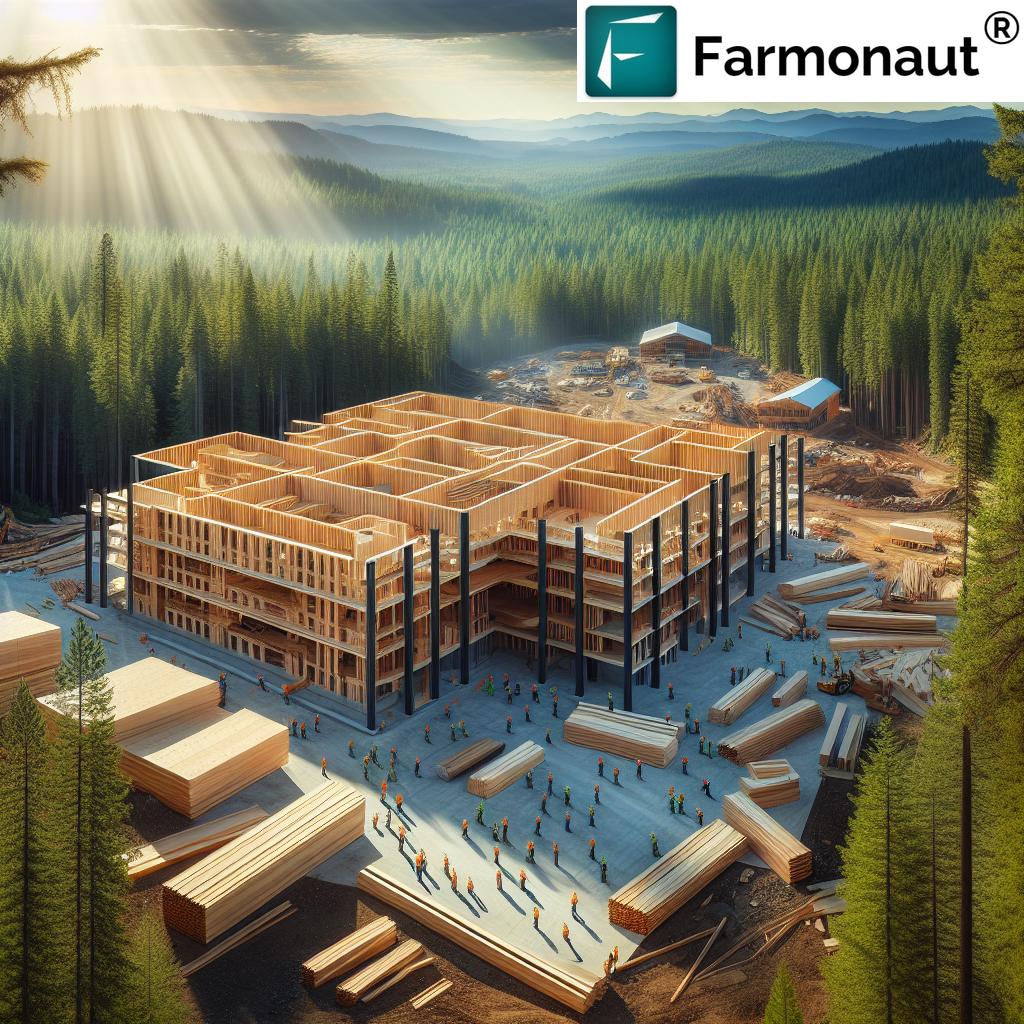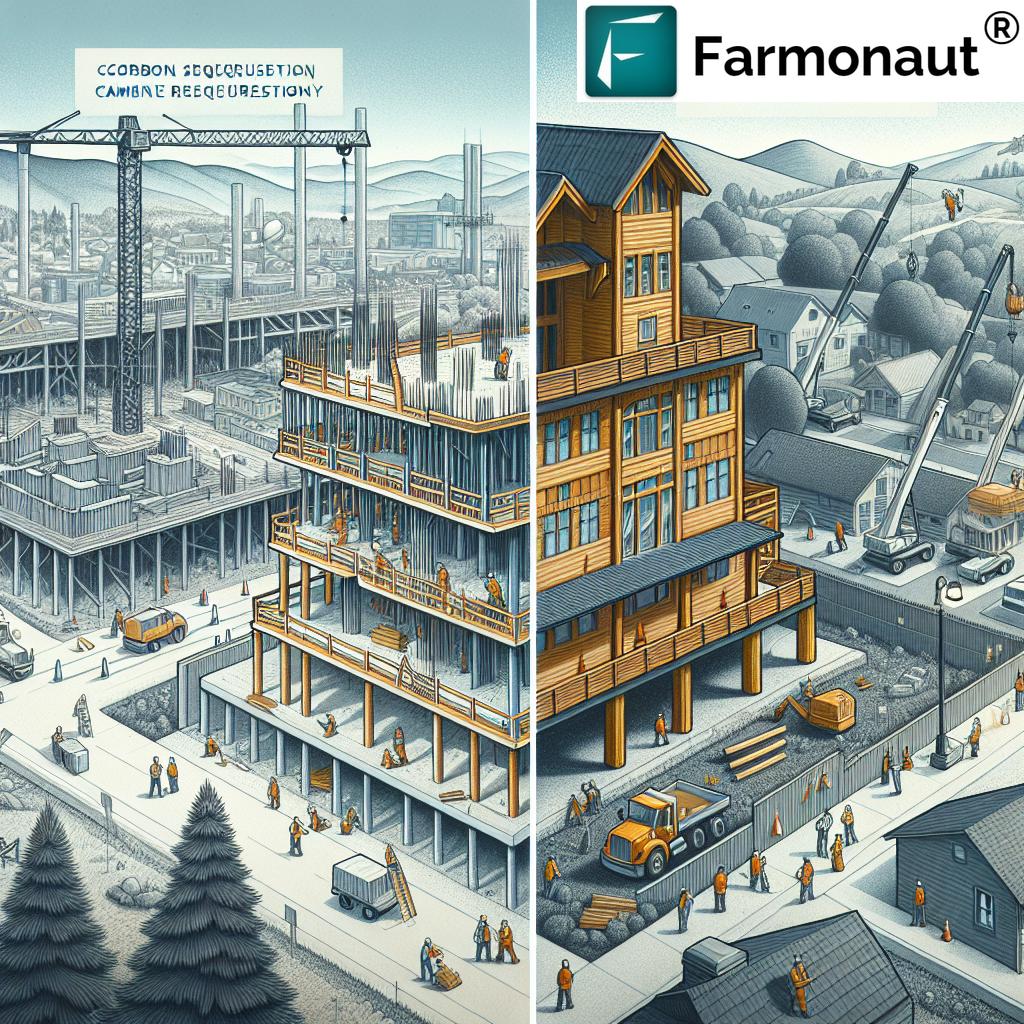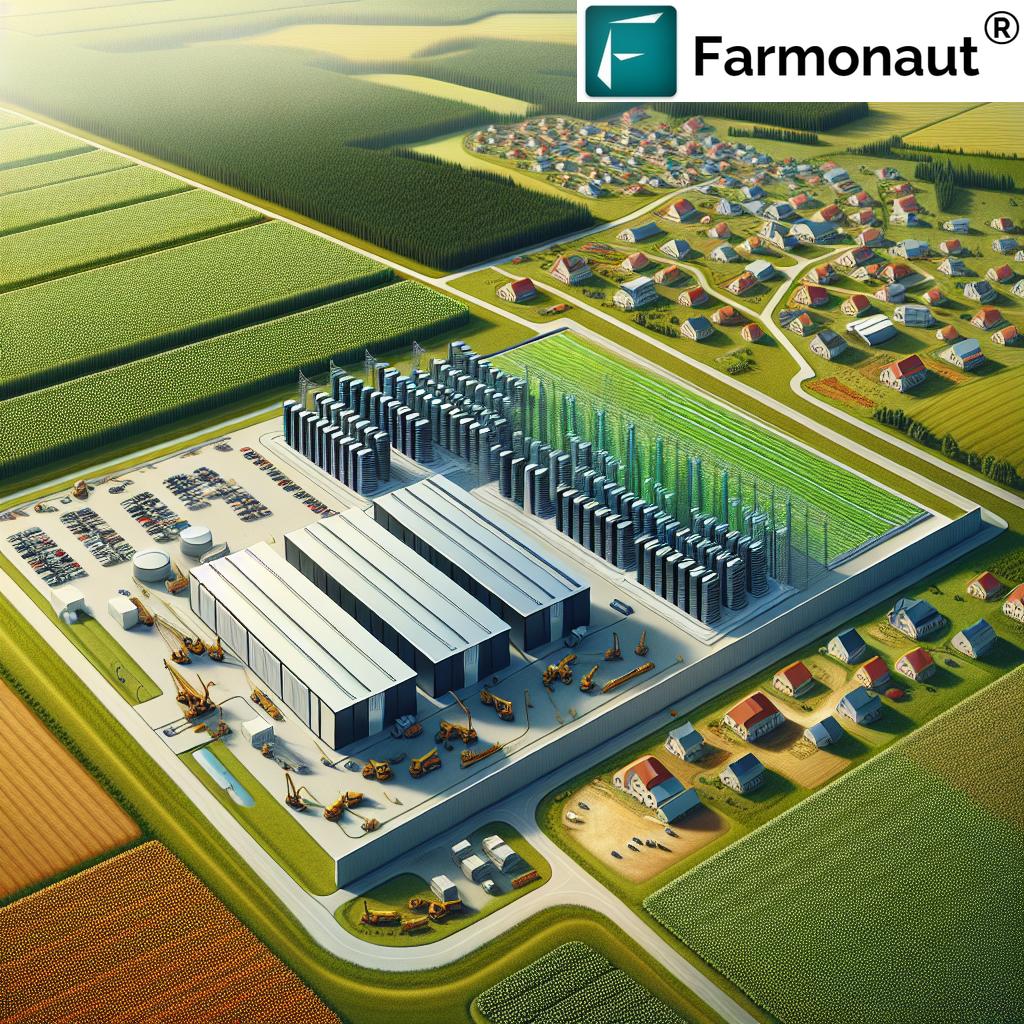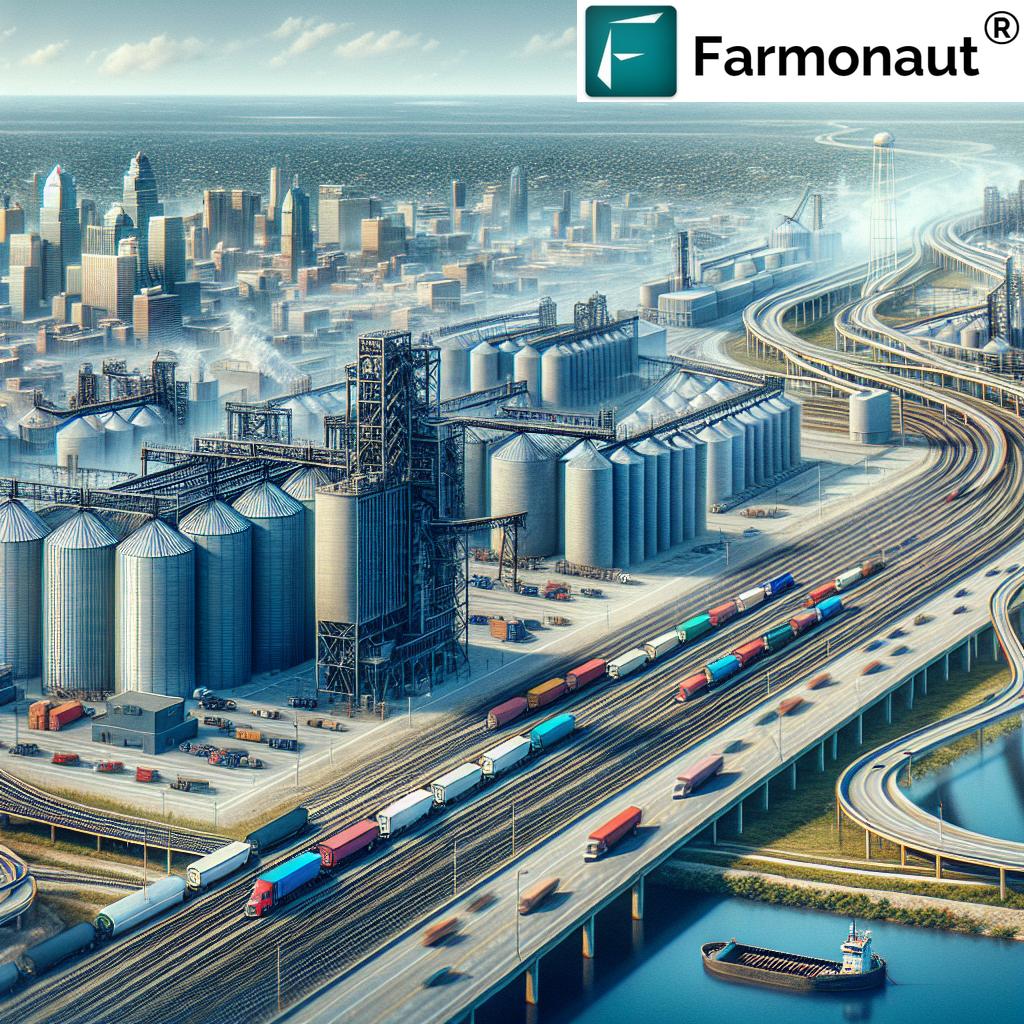Sustainable Future: Mass Timber Act Boosts Oregon’s Economy and Environment
“The Mass Timber Federal Buildings Act aims to reduce wildfire risk and create jobs in the timber industry simultaneously.”
In an era where sustainability and economic growth often seem at odds, we’re witnessing a groundbreaking legislative effort that promises to harmonize these crucial objectives. The Mass Timber Federal Buildings Act, a bipartisan initiative, is set to revolutionize sustainable construction in the United States while simultaneously bolstering rural economies and addressing critical environmental challenges.
Understanding the Mass Timber Revolution
Mass timber, an innovative category of engineered wood products, has emerged as a game-changer in the construction industry. This sustainable building material offers a compelling alternative to traditional carbon-intensive materials like concrete and steel. As we delve into the implications of this transformative legislation, let’s first explore what makes mass timber so remarkable.
- Environmentally friendly: Mass timber products sequester carbon, reducing the overall carbon footprint of buildings.
- Structurally sound: Engineered to be strong and durable, mass timber can compete with concrete and steel in many applications.
- Aesthetically pleasing: The natural beauty of wood adds warmth and character to buildings.
- Efficient construction: Prefabricated mass timber elements can significantly reduce on-site construction time.
The Mass Timber Federal Buildings Act recognizes these benefits and aims to leverage them for the greater good of our nation’s economy and environment.
Key Provisions of the Mass Timber Federal Buildings Act
This bipartisan legislation, introduced by Oregon’s U.S. Senator Jeff Merkley and Idaho’s U.S. Senator James Risch, sets forth a series of measures designed to promote the use of mass timber in federal building projects and military construction. Let’s break down the core components of this act:
- Preference in Federal Contracts: The act provides a preference for mass timber products in federal building contracts, enabling mass timber companies to compete more effectively for government projects.
- Two-Tier Contracting Preference:
- First Tier: Applies to mass timber made within the U.S. and responsibly sourced from state, federal, private, and Tribal forestlands.
- Second Tier (Optional): Applies to mass timber products sourced from restoration practices, fire mitigation projects, and/or underserved forest owners.
- Lifecycle Assessment Requirement: The bill mandates a whole building lifecycle assessment, which will provide concrete evidence of the carbon sequestration benefits of mass timber buildings.
These provisions are designed to create a ripple effect of positive outcomes, from supporting domestic manufacturing to enhancing forest management practices.

Environmental Benefits: A Sustainable Building Revolution
The environmental implications of this legislation are profound. By promoting the use of mass timber, we’re not just changing how we build; we’re actively combating climate change and improving our forest management practices.
Carbon Sequestration in Buildings
One of the most significant advantages of mass timber is its ability to sequester carbon. Unlike concrete and steel, which are carbon-intensive to produce, wood products store carbon throughout their lifecycle. This means that mass timber buildings act as long-term carbon sinks, helping to mitigate the effects of climate change.
Wildfire Risk Reduction
The act’s emphasis on sourcing timber from restoration practices and fire mitigation projects addresses another critical environmental concern: wildfire risk. By creating a market for smaller diameter trees and forest thinnings, we can encourage better forest management practices that reduce the fuel load in our forests, thereby decreasing the risk of catastrophic wildfires.
Sustainable Forest Management
The preference for responsibly sourced timber from various forestlands, including state, federal, private, and tribal lands, promotes sustainable forest management practices. This approach ensures that our forests remain healthy and productive for generations to come.
“The act promotes carbon sequestration in buildings while expanding markets for renewable construction materials across various forestlands.”
Economic Impact: Revitalizing Rural Communities
The Mass Timber Federal Buildings Act isn’t just an environmental win; it’s a powerful economic stimulus, particularly for rural communities that have long relied on the timber industry.
Job Creation in the Timber Industry
By incentivizing the use of mass timber in federal projects, this legislation creates a significant demand for innovative wood products. This demand translates directly into job creation across the entire timber industry supply chain, from forestry and logging to manufacturing and construction.
Rural Economic Development
Many rural communities in Oregon, Washington, Idaho, and across the Pacific Northwest have struggled with economic downturns as traditional timber industries have declined. The mass timber revolution offers these communities a chance to revitalize their economies by tapping into this growing market for sustainable building materials.
Expanding Markets for Renewable Construction Materials
The act’s focus on expanding markets for mass timber products helps to create a more diverse and resilient forest products industry. This diversification is crucial for long-term economic stability in timber-dependent regions.
Bipartisan Support: A Unified Approach to Sustainable Development
One of the most encouraging aspects of the Mass Timber Federal Buildings Act is its strong bipartisan support. This collaboration across party lines underscores the universal appeal of sustainable development that also bolsters economic growth.
Voices of Support
Let’s hear from some of the key supporters of this legislation:
- Senator Jeff Merkley (Oregon): “Mass timber creates jobs in rural and urban communities, reduces wildfire risk, increases forest resiliency, and helps us shrink our carbon footprint.”
- Senator James Risch (Idaho): “As a trained forester, I understand how important the timber industry is to Idaho communities, wildfire risk reduction, and forest management.”
- Senator Ron Wyden (Oregon): “Mass timber has huge potential to generate jobs in Oregon, reduce carbon emissions, and build an innovative approach to combat the shortage of housing in Oregon and nationwide.”
- Senator Mike Crapo (Idaho): “Boosting demand for Idaho timber in the construction of federal buildings will harness the incredible work already done in our forests, and create new opportunities for Idaho companies, workers and products.”
This broad support base suggests that the act has a strong chance of becoming law, paving the way for a more sustainable and prosperous future.
Comparative Analysis: Mass Timber vs. Traditional Construction Materials
To fully appreciate the impact of the Mass Timber Federal Buildings Act, it’s crucial to understand how mass timber compares to traditional construction materials. The following table provides a clear comparison:
| Material | Carbon Footprint | Wildfire Risk Reduction | Job Creation Potential | Renewable Resource |
|---|---|---|---|---|
| Mass Timber | Low | High | High | Yes |
| Concrete | High | Low | Moderate | No |
| Steel | High | Low | Moderate | Partially (recyclable) |
As we can see, mass timber outperforms traditional materials in several key areas, particularly in terms of environmental impact and potential for rural job creation.
Industry Support and Endorsements
The Mass Timber Federal Buildings Act has garnered support from a wide range of industry organizations and companies. This broad endorsement underscores the act’s potential to transform the construction and forestry sectors.
- American Wood Council: “This is a win-win proposal: not only would the bill expand markets and support domestic manufacturing; it would also support active forest management, help reduce wildfire risk and create jobs in forestry, manufacturing and construction.”
- Sustainable Northwest: “This practical legislation will spur use of innovative wood products in public buildings, support American manufacturing, and build critical markets for restoration of our nation’s forests.”
- Forest Landowners Association: “By replacing carbon-intensive materials with American-grown timber, this policy strengthens our wood products supply chain, supports rural economies, and ensures the future of our working forests.”
- National Alliance of Forest Owners (NAFO): “When we build with American-grown wood, we bolster our nation’s private working forests and the rural communities that depend on them.”
These endorsements highlight the act’s potential to create a virtuous cycle of sustainable forest management, economic growth, and environmental protection.

Implications for the Construction Industry
The Mass Timber Federal Buildings Act is set to revolutionize the construction industry, particularly in the realm of public and military buildings. Here’s how:
Innovation in Building Design
By incentivizing the use of mass timber, the act encourages architects and engineers to explore innovative design solutions. Mass timber’s unique properties allow for creative architectural expressions while maintaining structural integrity.
Streamlined Construction Processes
Mass timber construction often involves prefabrication, which can significantly reduce on-site construction time. This efficiency translates to cost savings and faster project completion times for federal buildings.
Skills Development
As the demand for mass timber construction grows, we’ll likely see an increased focus on training and skills development in this area. This could lead to new specializations within the construction industry and create more high-skilled job opportunities.
Global Context: Leading the Way in Sustainable Construction
The United States is not alone in recognizing the potential of mass timber. Countries around the world are increasingly turning to this sustainable building material. However, with the Mass Timber Federal Buildings Act, the U.S. has an opportunity to become a global leader in this field.
International Comparisons
Countries like Canada, Austria, and Norway have been at the forefront of mass timber construction. By learning from their experiences and combining them with our own innovative approach, we can set new global standards for sustainable building practices.
Export Potential
As we develop our domestic mass timber industry, we also create opportunities for exporting our products and expertise. This could position the United States as a key player in the global sustainable construction market.
The Role of Technology in Sustainable Forestry and Construction
While the Mass Timber Federal Buildings Act focuses on traditional forestry and construction practices, it’s important to recognize the role that modern technology plays in making these industries more sustainable and efficient. Companies like Farmonaut are at the forefront of this technological revolution in agriculture and land management.
Farmonaut’s satellite-based farm management solutions offer valuable insights that can be applied to sustainable forestry practices. While Farmonaut primarily focuses on agricultural applications, the principles of precision management and data-driven decision-making are equally relevant to forest management.
Some key technologies that complement the goals of the Mass Timber Federal Buildings Act include:
- Satellite Imagery: Used for monitoring forest health and identifying areas for sustainable harvesting.
- AI and Machine Learning: Can help predict wildfire risks and optimize forest management strategies.
- Blockchain: Ensures traceability in the timber supply chain, verifying the sustainable sourcing of mass timber products.
While Farmonaut’s specific services are tailored for agriculture, the company’s innovative approach to land management aligns with the broader goals of sustainability and efficiency promoted by the Mass Timber Federal Buildings Act.
For those interested in learning more about advanced agricultural technologies, you can explore Farmonaut’s offerings:
Challenges and Considerations
While the Mass Timber Federal Buildings Act offers numerous benefits, it’s important to address potential challenges and considerations:
Supply Chain Development
Ramping up mass timber production to meet increased demand will require significant investment in manufacturing facilities and supply chain infrastructure.
Building Code Adaptations
As mass timber becomes more prevalent, building codes may need to be updated to fully accommodate this material’s unique properties and applications.
Balancing Forest Use
While the act promotes sustainable forestry, careful management will be crucial to ensure that increased timber demand doesn’t lead to overexploitation of forest resources.
Looking to the Future: The Long-Term Impact of the Mass Timber Federal Buildings Act
As we look ahead, the potential long-term impacts of this legislation are truly exciting:
- Carbon Neutral Buildings: Widespread adoption of mass timber could lead to a new era of carbon-neutral or even carbon-negative buildings.
- Revitalized Rural Economies: The act could spark a renaissance in rural communities that have long relied on the timber industry.
- Innovative Architecture: As architects and engineers become more familiar with mass timber, we may see a new wave of innovative and sustainable building designs.
- Enhanced Forest Management: The increased demand for sustainably sourced timber could lead to more robust and scientifically-driven forest management practices.
The Mass Timber Federal Buildings Act is more than just a piece of legislation; it’s a roadmap to a more sustainable and prosperous future for our built environment and our rural communities.
Conclusion: A Sustainable Path Forward
The Mass Timber Federal Buildings Act represents a significant step towards a more sustainable and economically vibrant future. By promoting the use of mass timber in federal construction projects, this bipartisan legislation addresses multiple critical challenges facing our nation:
- Reducing our carbon footprint
- Mitigating wildfire risks
- Creating jobs in rural communities
- Encouraging sustainable forest management
- Driving innovation in the construction industry
As we move forward, it’s clear that the success of this act will depend on the collaborative efforts of government agencies, private industry, and local communities. By working together, we can harness the full potential of mass timber to build a more sustainable, resilient, and prosperous future for all Americans.
The Mass Timber Federal Buildings Act is not just about constructing buildings; it’s about constructing a better tomorrow. It’s a testament to what we can achieve when we align our economic goals with our environmental responsibilities, creating solutions that benefit both our communities and our planet.
FAQ Section
Q: What is mass timber?
A: Mass timber refers to engineered wood products made by layering wood sections to create strong, lightweight structural components. Common types include cross-laminated timber (CLT), glued laminated timber (glulam), and laminated veneer lumber (LVL).
Q: How does the Mass Timber Federal Buildings Act benefit the environment?
A: The act promotes the use of sustainable building materials that sequester carbon, reduces wildfire risk through better forest management, and encourages the use of renewable resources in construction.
Q: Will this act create jobs?
A: Yes, the act is expected to create jobs across the timber industry supply chain, from forestry and logging to manufacturing and construction, particularly benefiting rural communities.
Q: How does mass timber compare to traditional building materials in terms of safety?
A: Mass timber has been extensively tested and, when properly designed and constructed, can meet or exceed safety standards for fire resistance and structural integrity comparable to concrete and steel.
Q: Does the act apply to all federal buildings?
A: The act provides a preference for mass timber in federal building contracts and military construction, but it doesn’t mandate its use in all federal buildings.
Earn With Farmonaut
Earn 20% recurring commission with Farmonaut’s affiliate program by sharing your promo code and helping farmers save 10%. Onboard 10 Elite farmers monthly to earn a minimum of $148,000 annually—start now and grow your income!
Farmonaut Subscriptions
















